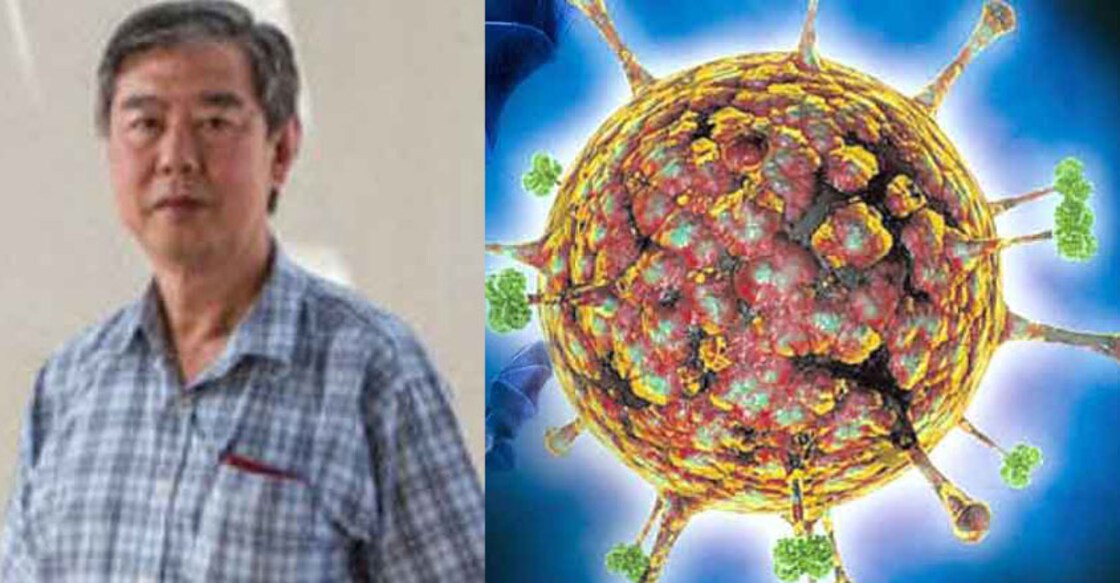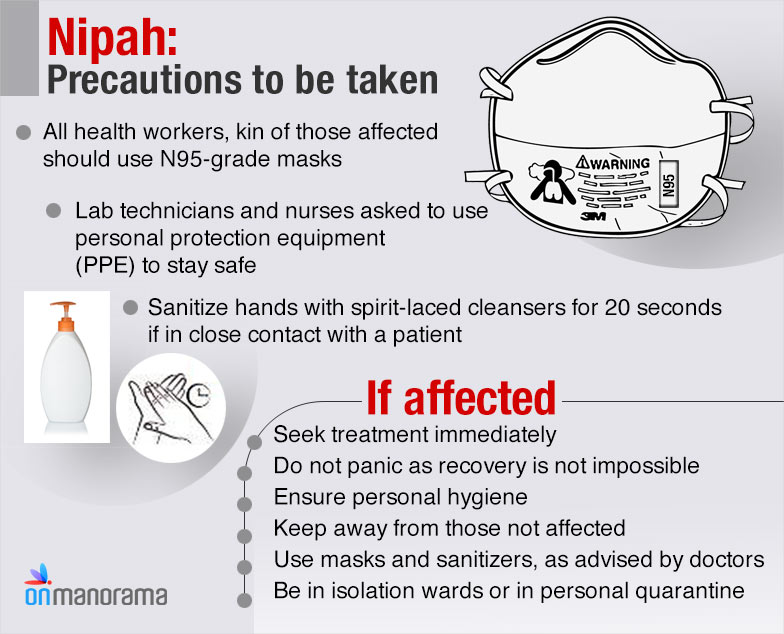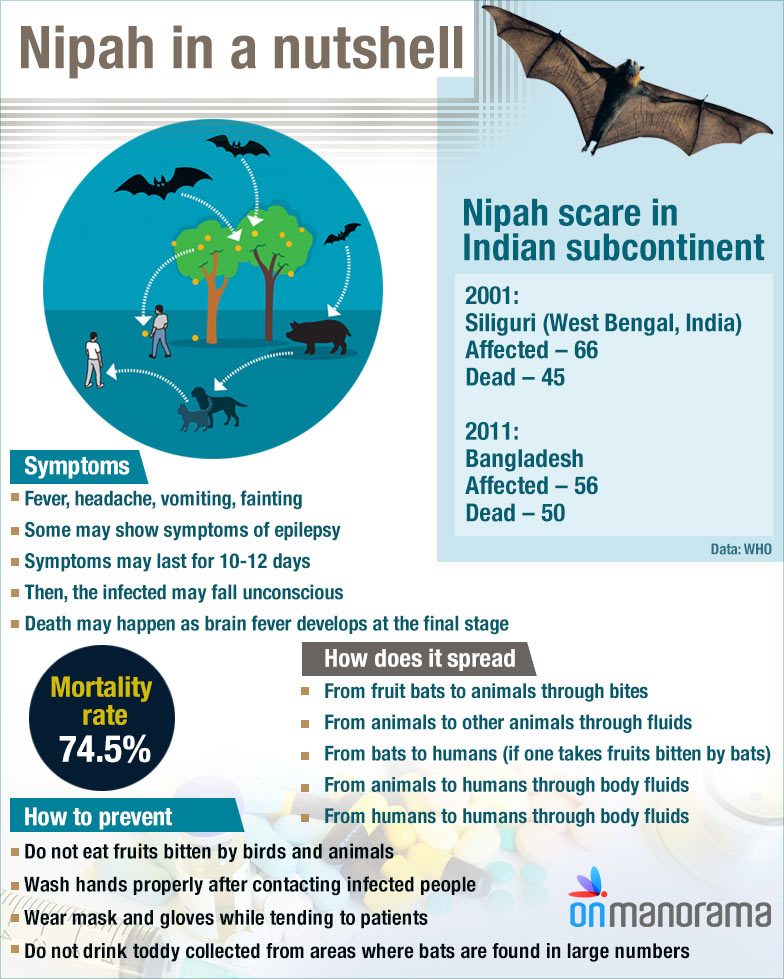Tracing the origin of Nipah

Mail This Article
It's official. The Nipah virus is in town once again. A college student from Thodupuzha in Idukki district was diagnosed with the disease almost a year after the Nipah scare left the coasts of Malabar. Last time the virus claimed 17 lives -- 14 in Kozhikode and three in the neighbouring district of Malappuram. Whether the virus will be deadlier in its second avatar in Kerala is yet to be seen.
Though caution needs to be exercised at all levels, the disease at present has not reached epidemic proportions.
Retracing the history of this little-known virus, which appeared in India's southern state a year ago, might prove fruitful in the journey forward.
According to the World Health Organisation (WHO), the Nipah Virus is an RNA virus that was first identified as a zoonotic (spread from animals to humans) pathogen after a 1999 outbreak involving severe respiratory illness in pigs and encephalitic disease in humans.
The etymology of the virus can be traced to its place of origin – Kampung Sungai Nipah, Malaysia. In 1999, pig farmers in Nipah were diagnosed with a curious disease which started off with mild flu like symptoms — fever, headache and so forth. The authorities' attempt to curb the disease with a dosage of Japanese encephalitis antidote was, however, to no avail. The rapid spread of the disease and the rise in fatality levels – around 40% of those infected at the time -- soon created wide spread alarm among the farmers and the general public.
Dr Kaw Bing Chua, a trainee virologist at the University of Malaya in Kaula Lumpur identified that something was amiss. It was not a mosquito driven disease as suspected by the authorities, he concurred. When his seniors spurned him for his suspicions about the new virus, the young scholar packed his bags and took the sample of virus to the United Status for testing.
He soon discovered that the virus belonged to the deadly group of paramyxoviruses known for its contagious temperament.
Chua quickly approached the Malaysian government and informed them that they were barking up the wrong tree. There was a reason why the Muslims in the area failed to contract the disease – they did not consume pork. Taking cue from his findings, authorities examined the first likely carrier of the disease – pigs. Their suspicions were soon confirmed by tests. The virus which had first manifested in forest fruit bats appeared in pigs when the pigs ate the bat excreta.
Interestingly, an increasing number of forest fruit bats had made an appearance in human settlements of the area in the late 1990s. According to a paper by Looi LM and Chua KB (2007) himself, the El-Nino driven drought and anthropogenic forest fires might have been the reason for this migration. The fruit orchards which were integrated with the pig farms facilitated the process.
The government was on a rampage after the findings came in. Pig culling – segregation of the diseased pigs from the breeding stock and killing them —caught the disease by its reins.
The consequent efforts of the Malaysian government to maintain cleaner pig farms with no chance of interaction with other animals and allocation of specific pockets for pig farming kept the disease at bay in the country.
It has since reappeared in Bangladesh and India at the turn of the new millennia.
The 2001 outbreak in Siliguri proved that the virus flourished in hospital environments.
The infestation of the palm juice (used as toddy) by the fruit bats was the reason for the Bangladesh Nipah virus outbreak in 2007.
As to why the virus made an appearance in Kerala is still a mystery for the general public. It might be bats, pigs or even humans.
Another curious factor is that the disease manifested itself with different symptoms in different areas. During the Bangladesh outbreak witnessed more respiratory symptoms as opposed to the Malaysian outbreak. The broad range of symptoms displayed by those affected by Nipah virus include flu-like symptoms like fever, headache, drowsiness, disorientation, mental confusion, acute respiratory infection, encephalitis, coma and death. The infestation of disease can result in perfectly healthy individuals ending up in a coma the next day with inflamed brains.
Nipah is an RNA virus, it is more predisposed to mutation than a DNA virus. Perhaps, this is one of the reasons for the aforementioned difference in manifestation. It is also one of the primary reasons why a permanent long lasting remedy for the disease is hard to come by despite its origin being traced to two decades ago. Experts have committed that the monoclonal antibodies from the National Institute of Virology will aid in arresting the disease to a certain extent.
But meanwhile it would be wise to exercise caution in the following areas:
Avoid eating fruits likely to be infested by bats, especially dates. The fruits must be washed thoroughly before consumption.
Avoid drinking toddy. Avoid eating pork.
Pig farmers should exercise great caution and observe their animals for any changes like open mouth breathing, leg weakness with muscle tremors and neurologic twitches. Stay away from people infected by the disease.
Get admitted immediately if any of the symptoms shows up.
Maintain quarantine of infected individuals. Hospital staff should exercise great caution while treating infected patients. Wearing of protection gear while approaching the patient and cleaning up afterwards could be a start.
Meanwhile, the government needs to focus on three areas: treatment of the infected, identification of the cause and its elimination thereof, and finding a cure to the disease.
The long term solution is of course, more allocation of resources -- financial and human -- to the R &D department for finding a suitable vaccine. The word is that the National Institute of Allergy and Infectious Diseases and Centres for Disease Control and Prevention, in US, seems to have found that a drug called Remdesivir, used to treat Ebola virus, could perhaps stop the virus dead in its tracks. If so, efforts must be taken to test its effectiveness and facilitate its availability after.





